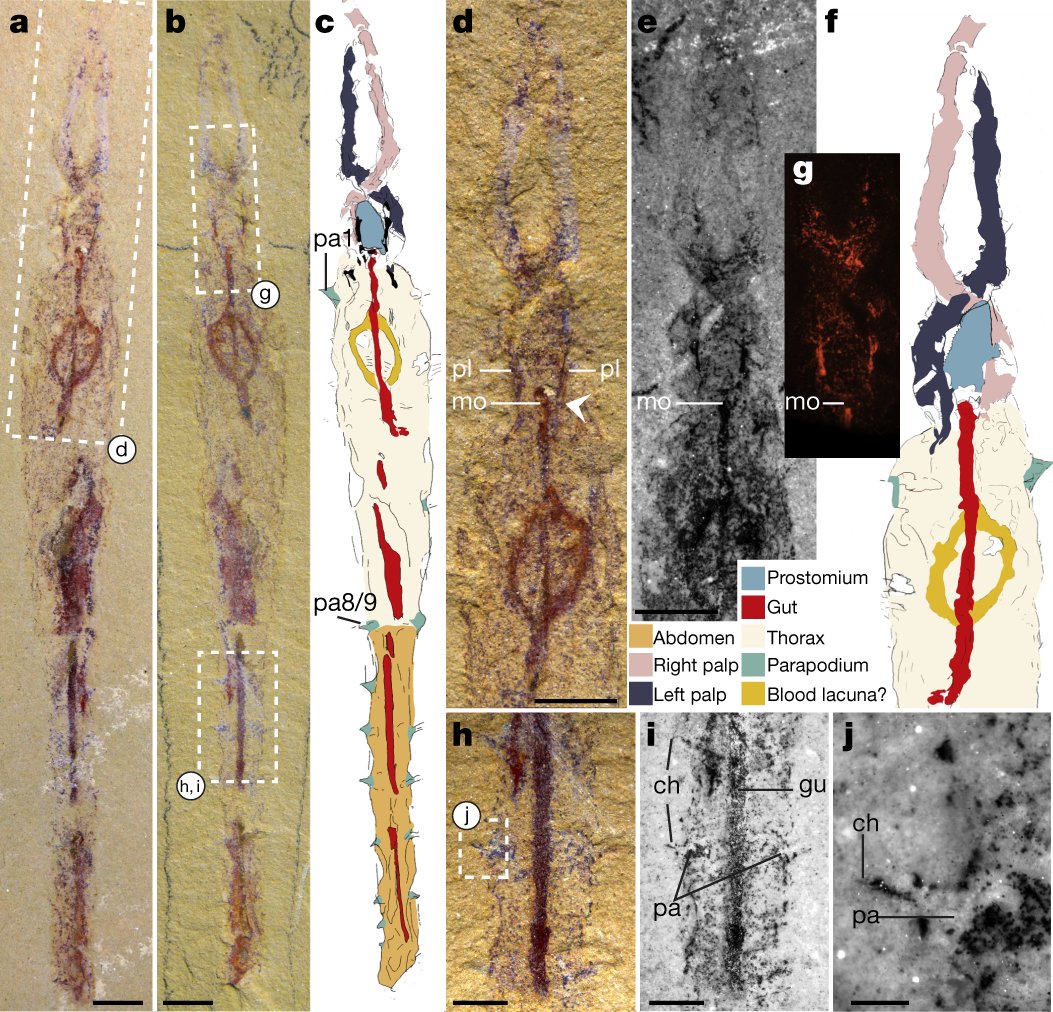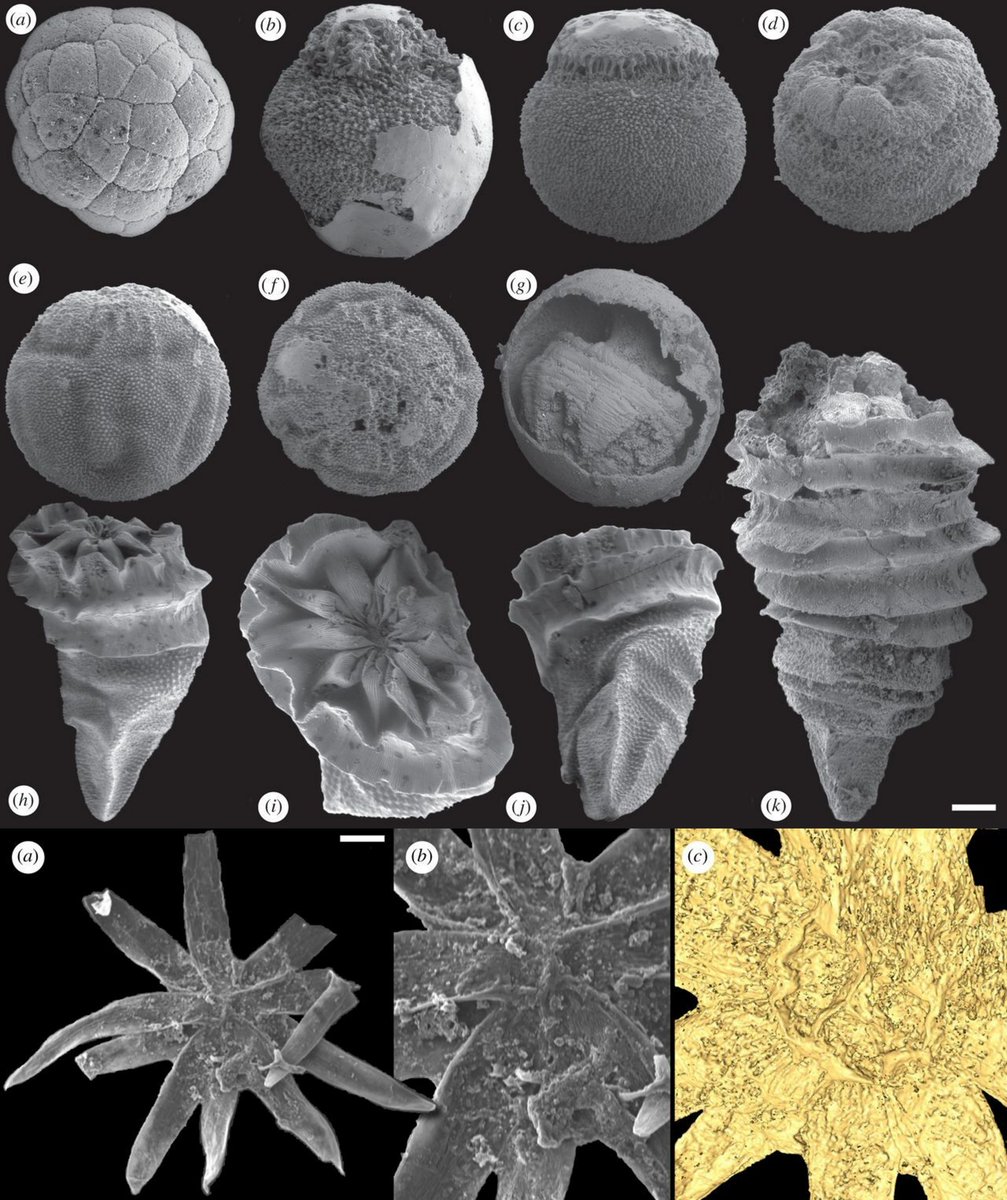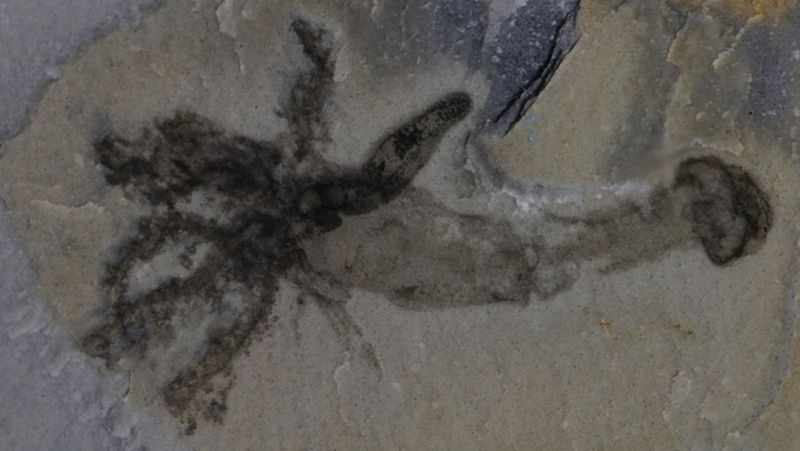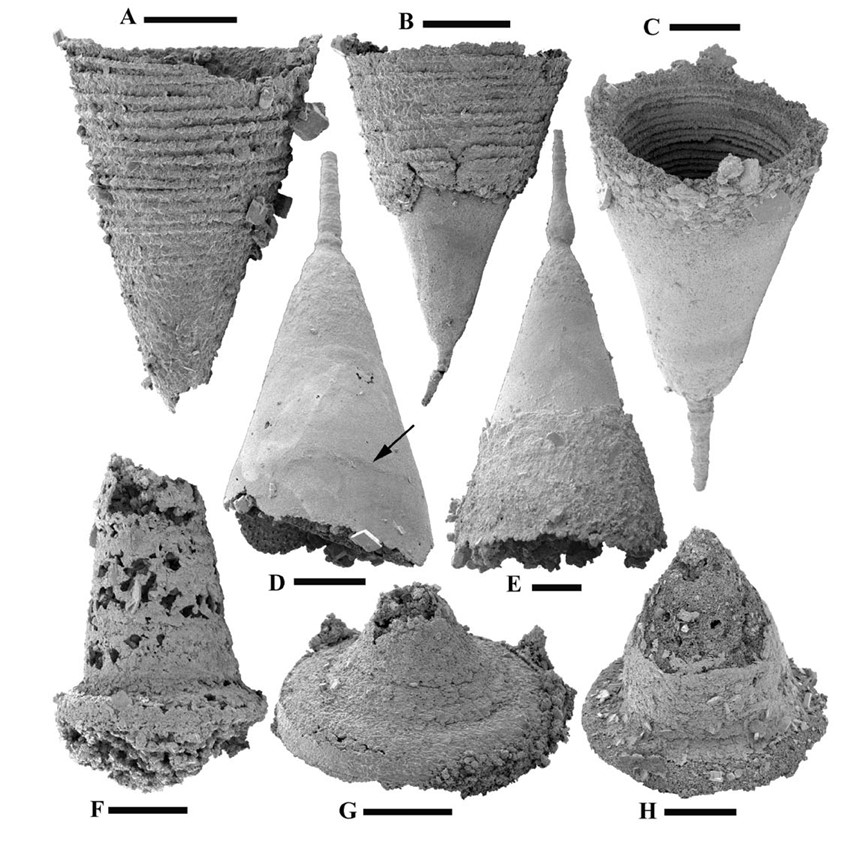The #Cambrian Explosion marks the first appearance of many animal phyla in the #fossil record, but just how radical was it? I'm starting a new #FossilFriday thread where I post Cambrian fossil representatives of one phylum per week. Join me on this trek across the tree of life 

Let's begin with #Annelida. In the #Cambrian these come mainly from deposits of exceptional preservation. Polychaetes and sipunculids, including species with potential affinities to living families, are represented.
#FossilFriday



#FossilFriday




Image references:
Canadia - Parry & Caron 2019
Dannychaeta - Parry et al. 2020
Kootenayscolex - Nanglu & Caron 2018
Archaeogolfingia and Cambrosipunculus - Huang et al. 2004
Canadia - Parry & Caron 2019
Dannychaeta - Parry et al. 2020
Kootenayscolex - Nanglu & Caron 2018
Archaeogolfingia and Cambrosipunculus - Huang et al. 2004
#Arthropods may have the best #Cambrian #fossil record of any phylum, including diverse representatives of major living groups (e.g. chelicerates, mandibulates), extinct groups (e.g. #trilobites), and even specialized parasitic forms (e.g. pentastomids), preserved in varied ways. 







Images references:
Waptia - Vannier at al. 2018
Mollisonia - Aria & Caron 2019
Aengapentastomum - Waloszek et al. 2005
various trilobites and unknown arthropod - Lerosey-Aubril et al. 2012
Waptia - Vannier at al. 2018
Mollisonia - Aria & Caron 2019
Aengapentastomum - Waloszek et al. 2005
various trilobites and unknown arthropod - Lerosey-Aubril et al. 2012
B is for #Brachiopoda, our next #FossilFriday phylum. The #Cambrian was the heyday for these animals. In addition to major living groups like linguliformeans and rhynchonelliformeans, we had diverse extinct relatives like hyoliths and tommotiids which had multipart skeletons. 







Image references:
Lingulellotreta - Zhang et al. 2004
Micromitra - Topper et al. 2015
Hyoliths - Moysiuk et al. 2017
Tommotiids - Skovsted et al. 2014
Lingulellotreta - Zhang et al. 2004
Micromitra - Topper et al. 2015
Hyoliths - Moysiuk et al. 2017
Tommotiids - Skovsted et al. 2014
#Bryozoans are the new phylum on the block for the #Cambrian. Until last year their #fossil record was only known to extend back to the #Ordovician, but two new studies potentially push that date back tens of millions of years into the mid-Cambrian.
#FossilFriday

#FossilFriday


Image references:
Protomelission - Zhang et al. 2021
possible mineralized bryozoans - Pruss et al. 2022
Protomelission - Zhang et al. 2021
possible mineralized bryozoans - Pruss et al. 2022
Next phylum is #Chaetognatha, the arrow worms. Their jaws are found in some of the oldest #Cambrian rocks and we also have exceptional intact specimens with soft tissue preservation from #BurgessShale-type deposits. Some were also HUGE (relative to modern forms) at up to 10cm. 





Image references:
Protosagitta - Vannier et al. 2007
Capinatator - Briggs & Caron, 2017
Protoconodonts - Vannier et al. 2007
Protosagitta - Vannier et al. 2007
Capinatator - Briggs & Caron, 2017
Protoconodonts - Vannier et al. 2007
Today's #FossilFriday phylum is our own, #Chordata. These are well-represented in the #Cambrian by fish-like forms with characteristic muscle bands and a possible tunicate. In the late Cambrian we get the first #conodonts, phosphatic jaw-like elements from early jawless chordates 







Images references:
Metaspriggina - Conway Morris & Caron, 2014
Pikaia - Conway Morris & Caron, 2012
Shankouclava - Chen et al. 2003
conodonts - Landing et al. 2011
Thanks also to @KNanglu for discussion!
Metaspriggina - Conway Morris & Caron, 2014
Pikaia - Conway Morris & Caron, 2012
Shankouclava - Chen et al. 2003
conodonts - Landing et al. 2011
Thanks also to @KNanglu for discussion!
Our next phylum is #Ctenophora. Superficially, #Cambrian and modern comb jellies look similar, but the former are much more disparate. Modern forms have 8 "comb rows" of cilia, but Cambrian forms could have more - up to 80! Other relatives may have had hard skeletons or stalks 







Image references:
various Burgess ctenophores - Zhao et al. 2019
Thaumactena ensis - Ou et al. 2015
Thalassostaphylos - Parry et al. 2021
Daihua - Zhao et al. 2019
various Burgess ctenophores - Zhao et al. 2019
Thaumactena ensis - Ou et al. 2015
Thalassostaphylos - Parry et al. 2021
Daihua - Zhao et al. 2019
@UofT_Palaeo Cnidaria is known from at least the late #Ediacaran, primarily from tiny phosphatized remains as well as tubes attributed to the phylum. By #Cambrian times, major subgroups such as hexacorals (incl. modern corals and anemones), scyphozoa (true jellies), & hydroids had diverged. 







@UofT_Palaeo Image references:
Possible conulariid, Lantian biota - Van Iten et al. 2014
Eolympia pediculata - Han et al. 2010
Olivooides - Dong et al. 2013
Palaeodiphasia simplex - Song et al. 2021
Possible conulariid, Lantian biota - Van Iten et al. 2014
Eolympia pediculata - Han et al. 2010
Olivooides - Dong et al. 2013
Palaeodiphasia simplex - Song et al. 2021
@UofT_Palaeo Members of #Echinodermata in the #Cambrian experimented with different kinds of symmetry, including bilateral, radial, and none at all! Some also had fish-like gill pores. The diversity of echinoderm form continued to increase, reaching its peak in the #Ordovician.
#FossilFriday


#FossilFriday



@UofT_Palaeo Image references:
various echinoderms - Zamora et al. 2012
Sineocrinus - Parsley & Zhao, 2006
Stromatocystites - Zamora, 2013
various echinoderms - Zamora et al. 2012
Sineocrinus - Parsley & Zhao, 2006
Stromatocystites - Zamora, 2013
@UofT_Palaeo A few #Cambrian #fossils, such as Cotyledion and Dinomischus have been proposed to have affinities with Phylum Entoprocta, but they've also been associated with other phyla. If true, though, it would mean that early members of this phylum were much larger than those left today. 



@UofT_Palaeo Photo references:
Cotyledion tylodes - Zhang et al. 2013
Dinomischus isolatus - burgess-shale.rom.on.ca/fossils/dinomi…
#FossilFriday
Cotyledion tylodes - Zhang et al. 2013
Dinomischus isolatus - burgess-shale.rom.on.ca/fossils/dinomi…
#FossilFriday
@UofT_Palaeo Some #Cambrian members of #Hemichordata lived in large elaborate tubes while others used tentacles to feed. These forms bridge the gap between the two major modern subgroups, the acorn worms and the tiny colonial pterobranchs. #FossilFriday 







@UofT_Palaeo Image references:
Oesia disjuncta (Nanglu et al. 2016)
Spartobranchus tenuis (Caron et al. 2013)
Gyaltsenglossus senis (Nanglu et al. 2020)
Cephalodiscus-like tubes (Maletz et al. 2005)
Oesia disjuncta (Nanglu et al. 2016)
Spartobranchus tenuis (Caron et al. 2013)
Gyaltsenglossus senis (Nanglu et al. 2020)
Cephalodiscus-like tubes (Maletz et al. 2005)
@UofT_Palaeo Minute #Cambrian #fossils, representing among the oldest ecdysozoans, have been associated with #Kinorhyncha, though they have also been allied with priapulids in other studies. However, if correct, they are the only #fossil representatives of this phylum. #FossilFriday 



@UofT_Palaeo Image references:
Eokinorhynchus rarus - Zhang et al. 2015
Zhongpingscolex qinensis - Shao et al. 2020
Eokinorhynchus rarus - Zhang et al. 2015
Zhongpingscolex qinensis - Shao et al. 2020
Phylum #Loricifera was only discovered in 1983, as these tiny animals live between sediment grains. Some #Cambrian forms look similar to their modern counterparts while others were comparative giants, hinting that this clade had macroscopic ancestry. #FossilFriday 



@UofT_Palaeo As today, phylum #Mollusca included disparate body forms in the #Cambrian. Nearly all modern classes (e.g. bivalves, cephalopods, gastropods) can trace their ancestry to this time. Alongside are stem #molluscs that help to bridge the divide with other phyla. #FossilFriday 







@UofT_Palaeo Image references:
Odontogriphus omalus - Caron et al. 2006
Plectronoceras - Kröger et al. 2011
Pojetaia runnegari - Parkhaev, 2008
Aldanella spp. - Parkhaev, 2008
Odontogriphus omalus - Caron et al. 2006
Plectronoceras - Kröger et al. 2011
Pojetaia runnegari - Parkhaev, 2008
Aldanella spp. - Parkhaev, 2008
Likely because of their small size and simple morphology, no convincing #Ediacaran / #Cambrian body #fossils of #Nematoda have been found yet, though some trace fossils (burrows and boreholes) have been tentatively attributed to them. #FossilFriday 



@UofT_Palaeo Image references:
Multina minima - Parry et al. 2017
possible nematode boreholes - Robson & Pratt, 2006
Multina minima - Parry et al. 2017
possible nematode boreholes - Robson & Pratt, 2006
@UofT_Palaeo Some #Cambrian #fossils have been associated with #Nematomorpha, though affinities with other cycloneuralian worms are difficult to rule out. Perhaps the most compelling is Shergoldana, which resembles a modern nematomorph larva. #FossilFriday 

@UofT_Palaeo Image reference:
Shergoldana australiensis - Maas et al. 2007
Shergoldana australiensis - Maas et al. 2007
@UofT_Palaeo Various lobopodians share features with #Onychophora, like their pustulose cuticle and stacked claw construction. Some of these characteristics might have evolved deeper in the panarthropod group, but nonetheless they show that this phylum has deep #Cambrian roots. #FossilFriday 



@UofT_Palaeo Image references:
Hallucigenia sparsa - Smith & Ortega-Hernández, 2014
Antennacanthopodia gracilis - Ou et al. 2011
Hallucigenia sparsa - Smith & Ortega-Hernández, 2014
Antennacanthopodia gracilis - Ou et al. 2011
@UofT_Palaeo While there are no undoubted #Cambrian #Phoronida, some potentially related #fossils seem to share some aspects of the phoronid body plan, like deep tubular bodies, and the ability to build tubes out of glued sediment grains. #FossilFriday 





@UofT_Palaeo Image references:
Eccentrotheca - Skovsted et al. 2008
Yuganotheca - Zhang et al. 2014
Skolithos burrows - Sundberg, 1983
Eccentrotheca - Skovsted et al. 2008
Yuganotheca - Zhang et al. 2014
Skolithos burrows - Sundberg, 1983
Abundant #Cambrian #fossils represent the major lineages of Porifera that are still with us today and probable stem groups. A number of #sponge-like fossils are also known from the #Ediacaran, but their affinities are controversial. #FossilFriday 







@UofT_Palaeo Image references:
Eiffelia - burgess-shale.rom.on.ca/fossils/eiffel…
Sanshapentella - Yun et al. 2022
spicules from the Yanjiahe Formation - Chang et al. 2016
Namapoikia - Wood & Penny 2018
Eiffelia - burgess-shale.rom.on.ca/fossils/eiffel…
Sanshapentella - Yun et al. 2022
spicules from the Yanjiahe Formation - Chang et al. 2016
Namapoikia - Wood & Penny 2018
@UofT_Palaeo #Cambrian #Priapulida are very diverse in form and well preserved, down to the teeth on their proboscises. We even know what they were feeding on from gut contents. Their burrow #fossils are also an important marker for the Cambrian Period onset. #FossilFriday 







Image references:
Selkirkia - Smith et al. 2015
Ottoia teeth - Smith et al. 2015
Ottoia with gut contents - Vannier 2012
Treptichnus burrows - Vannier et al. 2010
Selkirkia - Smith et al. 2015
Ottoia teeth - Smith et al. 2015
Ottoia with gut contents - Vannier 2012
Treptichnus burrows - Vannier et al. 2010
@UofT_Palaeo By the #Cambrian, #Tardigrada (water bears) had already evolved their short, miniaturized body plan. We also see more distantly related, larger lobopodian forms with tardigrade characteristics, like multiple claws. #FossilFriday 



Image references:
Siberian tardigrade - Maas & Waloszek 2001
Aysheaia - burgess-shale.rom.on.ca/fossils/ayshea…
Siberian tardigrade - Maas & Waloszek 2001
Aysheaia - burgess-shale.rom.on.ca/fossils/ayshea…
A few phyla remain to be discovered (Cycliophora, Dicyemida, Gastrotricha, Nemertea, Orthonectida, Placozoa, Platyhelminthes, Xenacoelomorpha), but there are lots of enigmatic #Cambrian #fossils yet to be identified! 







Image references:
unknown brachiopod parasite - Zhang et al. 2020
Cochleatina - Slater et al. 2020
Salterella - Skovsted, 2003
Pollingeria - burgess-shale.rom.on.ca/fossils/pollin…
unknown brachiopod parasite - Zhang et al. 2020
Cochleatina - Slater et al. 2020
Salterella - Skovsted, 2003
Pollingeria - burgess-shale.rom.on.ca/fossils/pollin…
@threadreaderapp unroll
• • •
Missing some Tweet in this thread? You can try to
force a refresh




